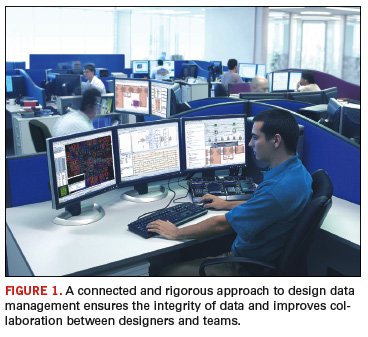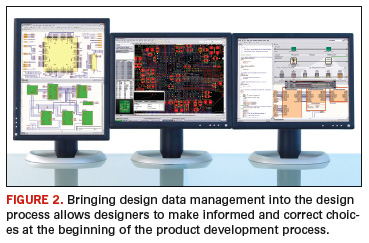Data Management 101

When data management is an integral part of the design environment, it works with designers rather than against them.
In all fields of engineering, a key factor in the success of any design project is having the right information available at the right time. A misinformed choice at such a seminal stage becomes increasingly difficult to correct as the design progresses, and its effect reverberates throughout all aspects of the design. For electronic product design, it might be as simple as selecting a component that has been discontinued or is in short supply, or perhaps more expensive than expected. Changing that part creates a design re-spin and triggers a flow-on increase in costs and product development time.
Either way, a mistake induced by design data that lacks ‘integrity’ is costly. In addition, that cost is amplified when the problem is exposed later in the design process; such as the procurement stage, when the part’s current price and availability status have become clear. In this case, the problem has propagated throughout the design chain and forced a redesign delay late in development.
This lack of integrity in the design data has most likely been caused by a failure in data management. Design data management, in itself a fairly broad term, is not a new challenge for electronics designers. It has traditionally existed at the local design level through the control of component libraries and file naming systems that keep track of design revisions. This approach works reasonably well in an isolated system where one task is performed because the integrity of the design data is managed at an application level–where design is done.
The scope and formality of data management might be scaled to a company’s particular demands, but its effectiveness has always been linked to how successfully it is adopted by those within the design workflow. However, data management systems have subsequently evolved in a way that is disconnected from the design process, making the challenge of implementing effective data management far greater.
The Rise Of Complexity
As the number of stages and the people involved in the product design process have increased, localized data management has given way to overarching systems that aim to collectively manage design data. This change tends to result in a complex system, or a collection of interconnected systems, that collates, logs and controls the design data generated and passed between the various design applications. It is an administrative layer imposed over the top of the existing workflow.
In a typical design environment based on a collection of ‘connected’ tools, the onus is on the design data management system to maintain and to track a wide range of unrelated data from a myriad of sources. The collection of specialist design tools use and store design data in very different ways and are invariably used by different people within different design teams. This would typically encompass several divisions within an organization, including electronics design, mechanical CAD, manufacturing, procurement, distribution and marketing.
As the data set evolves and changes throughout the design process, the data management system aims to provide everyone involved with access to the correct and current version of design information, while simultaneously managing and tracking changes. This is an undeniably impressive feat when all those goals are achieved.
The system is, nevertheless, complex and must be accessed outside of the design system itself. Both of these factors slow the design process, and in many cases, encourage designers to bypass the data management system as deadlines loom. A quick approach of simply passing the latest revision to a colleague or directly accessing the component information from a previous design can save significant time, but this puts data integrity at risk.
On the other hand, checking out the latest design files and then checking them back in when you’re done or finding them by trawling through the appropriate database library are the correct methods, but they are clumsily disconnected from the actual design process. This conventional approach to design data management exists as a supplemental process to the design workflow. It forces engineers to leave the design environment to source, deliver or process design data.
Since that system is also based on the data from a disparate set of design tools, with different data structures and versions of the same information, the added complication of conflicting data is likely to arise. For example, the component data for a device might be hosted and interpreted differently in the schematic capture, PCB and embedded design applications, and therefore, destined for inconsistency. Problems such as missing or outdated information may only be uncovered during procurement, or worse, manufacturing.
In short, successfully managing and maintaining the integrity of all data created in the design of a product is an enormous challenge for today’s design teams (FIGURE 1). Current data management systems are far from ideal and tend to pull designers away from the primary process of using their skills to create innovative and successful designs. As increased globalization puts the squeeze on product manufacturing costs and project deadlines; errors and delays in the design process are becoming more costly through missed market opportunities.

Restoring Order
Taking a broader view of the design data management problem shows that it is largely centered around two problems: the task of managing design data from multiple unrelated sources and the use of management systems that are disconnected from the design process.
The first step to resolving the complexity and the inconsistency issues of multiple design data sources is to use a single model of the project design data. This requires a design system that brings together all of the electronic design processes into one unified environment, where the design data can exist as a single entity.
In this way, schematic capture, PCB layout, embedded system development and manufacturing output all use the same data during the product development process. Importantly, the design management system only needs to access and to track one source of coherent data. Whether a company uses a commercial PLM system or simpler enterprise systems, a single pool of related design data is much easier and simpler to manage.
From an immediate and practical perspective, a unified system means that all of the design domains use the same component data model sourced, for example, from the same component library. ‘IC10’ in the schematic uses the same data set as ‘IC10’ in the PCB layout or BoM. The libraries can be managed as a single, centralized resource, so library data inconsistencies and duplication are eliminated.
The single library source approach also offers the potential of expanding the data content by adding procurement and assembly information. When parts are placed from the centralized database library, designers then have access to component parameters that will streamline the manufacturing process. Any parts with long lead times will be flagged to avoid manufacturing delays, and BoMs can be generated from the live database information to ensure accurate project costing.
As the centralized data pool relates to a single unified design system, version control becomes equally as easy to implement. The design files are accessed by the same application and offer format consistency, making the version control system simpler to set up and to manage. The design system can be extended with back-end collaboration servers and plug-in modules that target specific enterprise applications. If a company is confident that a full PLM system is justified, its implementation will be simpler because of the single design data set containing all relevant information.
Data Management At The Design Level
Regardless of how advanced or potentially effective an imposed data management system is, the process will ultimately fail if the user interface is ineffective. This is the interactive connection between a designer and the data management system, and its success will determine if information can be accessed easily and at the right time. In practice, there’s too much temptation to bypass an overly complex or cumbersome system, and relevant information must be available at designers’ fingertips–as key design decisions are being made (FIGURE 2).

To achieve these aims, design management systems need to be accessible to designers from within their working environment. Along with access to centralized libraries, the design system itself needs to support direct interfaces to the version control system being used by an organization. Designers can then retrieve and submit design data directly from within their normal design space, which encourages rigorous data management practices and streamlines the design file management process.
Perhaps most important, however, relevant design information is then easily available ‘at call’. As a result, designers can make informed and correct choices at critical times, such as at the beginning of the design process where decisions have a profound effect. Data management then becomes an inherent part of the creative design process, where it is most effective.
In a unified design system, this immediate access to key design information is then available to all designers and downstream users via one design environment. Design reuse and true collaborative design become practical thanks to the single source of design data and to each designer’s direct access to version control systems. Procurement, manufacturing, documentation, mechanical design, marketing and distribution all reach into that single source of design data, helping to bring products to market in less time and within budget.
The significant change with this approach is that design data management becomes an integral part of the design environment, and therefore, a process that works with designers rather than one that works against them. In the final analysis, the most brilliant design will not reach the market within budget or on time (maybe not at all) if the data management processes fail by allowing incorrect or corrupt design data to propagate throughout the process.
When the design data and its management are simplified and readily accessible to all those involved in the product development workflow, the risks and the cost of design data errors become clearer, easily predictable and more manageable. Because designers also have accurate and relevant design data on hand, they can easily make informed decisions and refocus on what they do best: creating innovative electronics designs that will clearly differentiate a product in the market. PCD&F
Rob Evans is in technical marketing with Altium Limited and can be reached at This email address is being protected from spambots. You need JavaScript enabled to view it..




